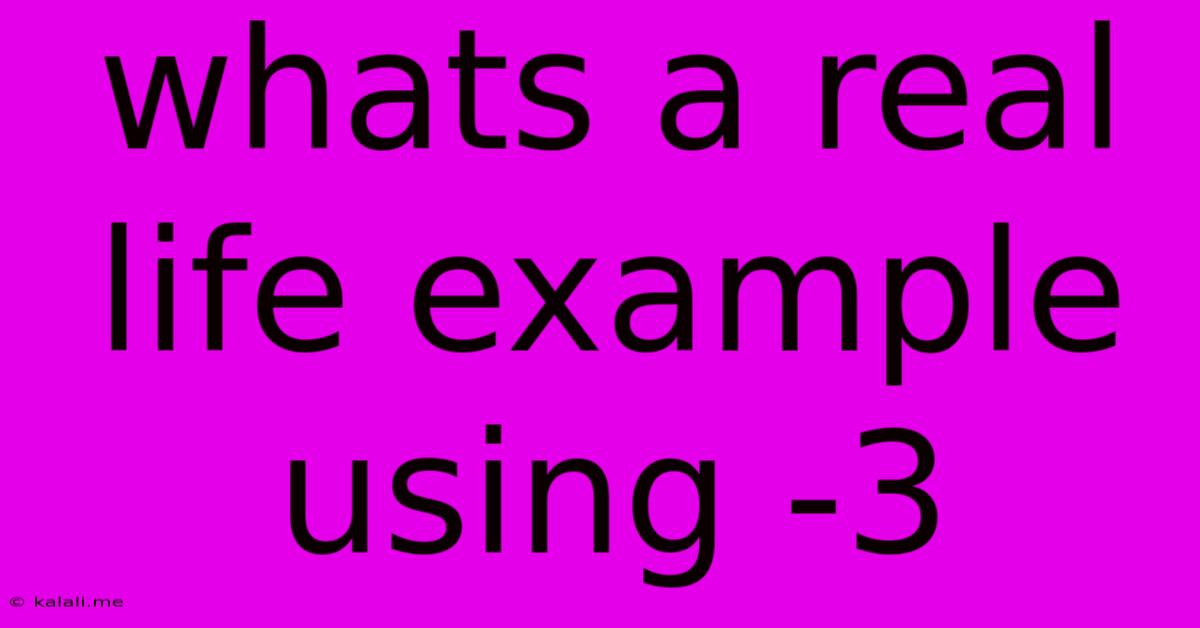Whats A Real Life Example Using -3
Kalali
Jun 07, 2025 · 3 min read

Table of Contents
Real-Life Examples Using -3: Beyond the Math Textbook
Negative numbers often feel abstract when confined to the classroom. But in reality, -3 and other negative numbers represent valuable concepts in everyday life. This article explores several practical examples showcasing the real-world application of -3, highlighting how understanding negative numbers enhances our grasp of various situations.
What does -3 really mean? Before diving into examples, it's crucial to understand that -3 fundamentally represents a deficit, a loss, or a direction opposite to a positive value. It's not just a number; it's a quantifier of something less than zero.
1. Financial Transactions: Debt and Withdrawals
One of the most straightforward applications of -3 is in personal finance. Imagine you have $0 in your bank account. If you write three checks for $1 each (or make three $1 withdrawals), your balance becomes -$3. This clearly illustrates a debt or a negative balance. This concept extends to larger debts, representing outstanding loans or credit card balances. -3 could represent a loss of $3, a negative investment return, or an overdraft.
2. Temperature Measurement: Below Freezing Point
Temperature scales often employ negative numbers. If the temperature is -3°C (or -3°F), it means it's 3 degrees below the freezing point of water. This is a common scenario in many parts of the world, especially during winter months. The negative sign indicates a temperature colder than the reference point (0°C/0°F).
3. Elevation and Depth: Below Sea Level
Geography provides another compelling context for negative numbers. The elevation of -3 meters signifies a location 3 meters below sea level. This is relevant in coastal areas or when discussing the depths of oceans, lakes, or mines. A depth of -3 meters simply means 3 meters below the reference point (sea level).
4. Game Scores and Statistics: Points Lost or Negative Yards
In many competitive games, negative numbers appear in scorekeeping or statistics. For instance, -3 points in a game could signify that a team has conceded three more points than they have scored. Similarly, in American football, -3 yards implies a loss of 3 yards following a play. This shows negative values representing setbacks or penalties.
5. Coordinate Systems: Location in Space**
In coordinate systems (like Cartesian coordinates), -3 represents a point located 3 units along the negative axis of a particular dimension. For instance, in a two-dimensional plane, the point (-3, 2) is 3 units to the left of the origin (0,0) and 2 units above. This is fundamental to mapping, graphics, and many other fields.
Conclusion:
These examples illustrate that -3, and negative numbers in general, aren't just mathematical abstractions; they're essential tools for representing real-world situations involving deficits, losses, directions opposite to a positive reference point, and positions below a baseline. Understanding negative numbers improves our ability to interpret data, make financial decisions, comprehend geographical concepts, and much more. The concept of -3 is far from theoretical; it’s deeply embedded in our daily experience.
Latest Posts
Latest Posts
-
Why Isnt Alfred File Search Working Ventura
Jun 07, 2025
-
Scriptures On The Last Days In The Bible
Jun 07, 2025
-
Can Incholate Crimes Involver A Minor Pretending To Be Someone
Jun 07, 2025
-
How Should Dispose Of Old Clogged Dryer Vent Piping
Jun 07, 2025
-
Did Both Thieves On The Cross Mock Jesus
Jun 07, 2025
Related Post
Thank you for visiting our website which covers about Whats A Real Life Example Using -3 . We hope the information provided has been useful to you. Feel free to contact us if you have any questions or need further assistance. See you next time and don't miss to bookmark.